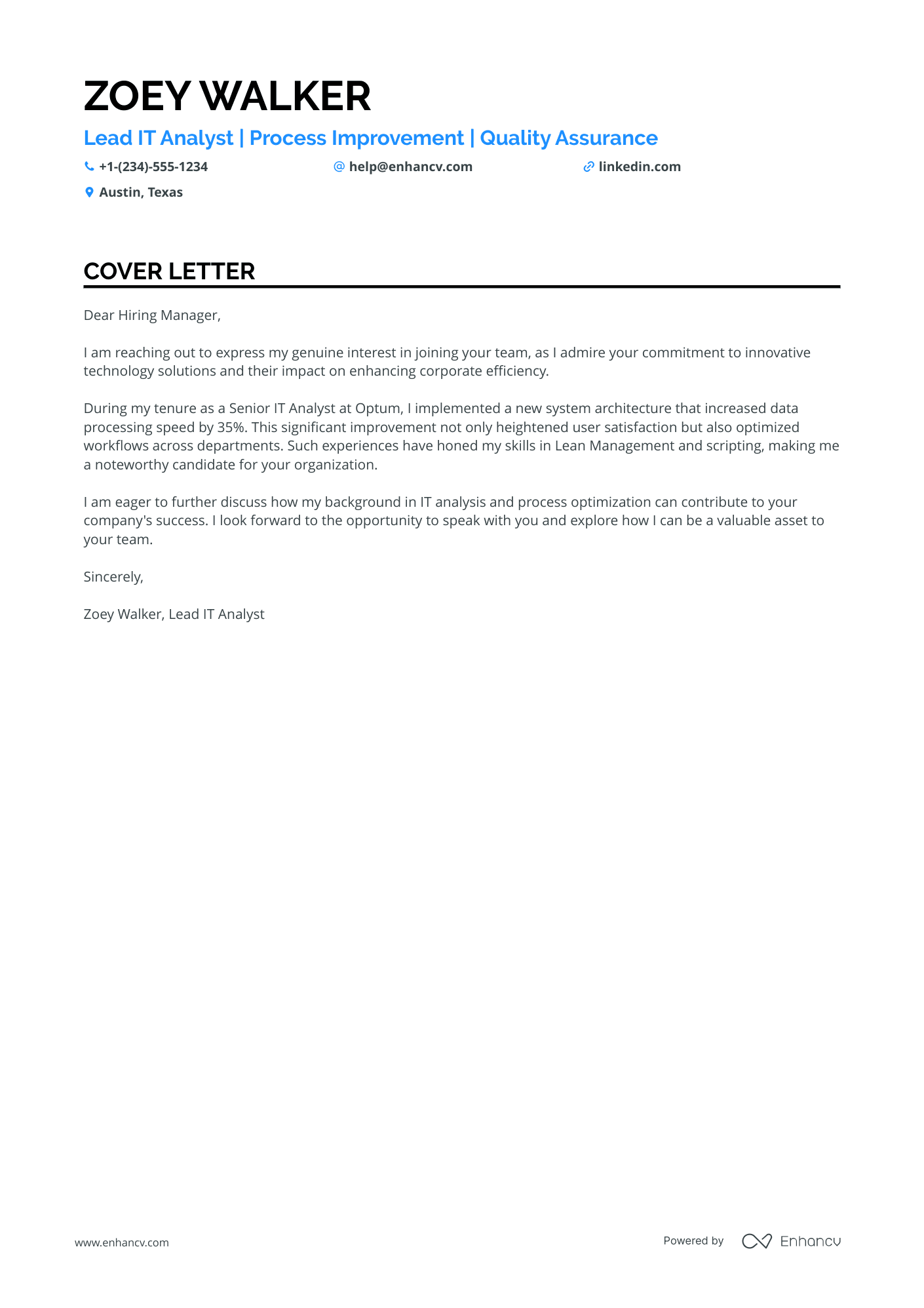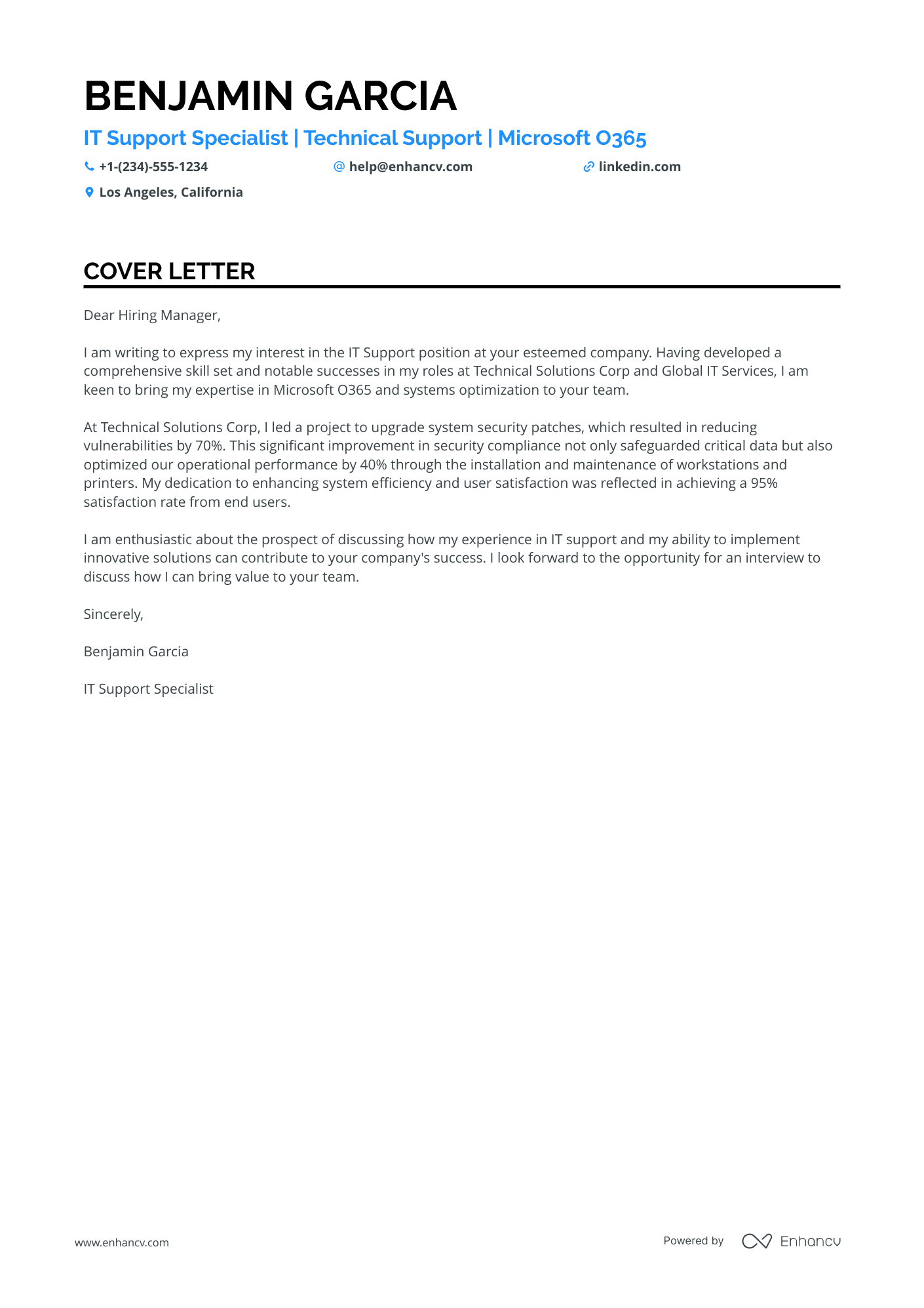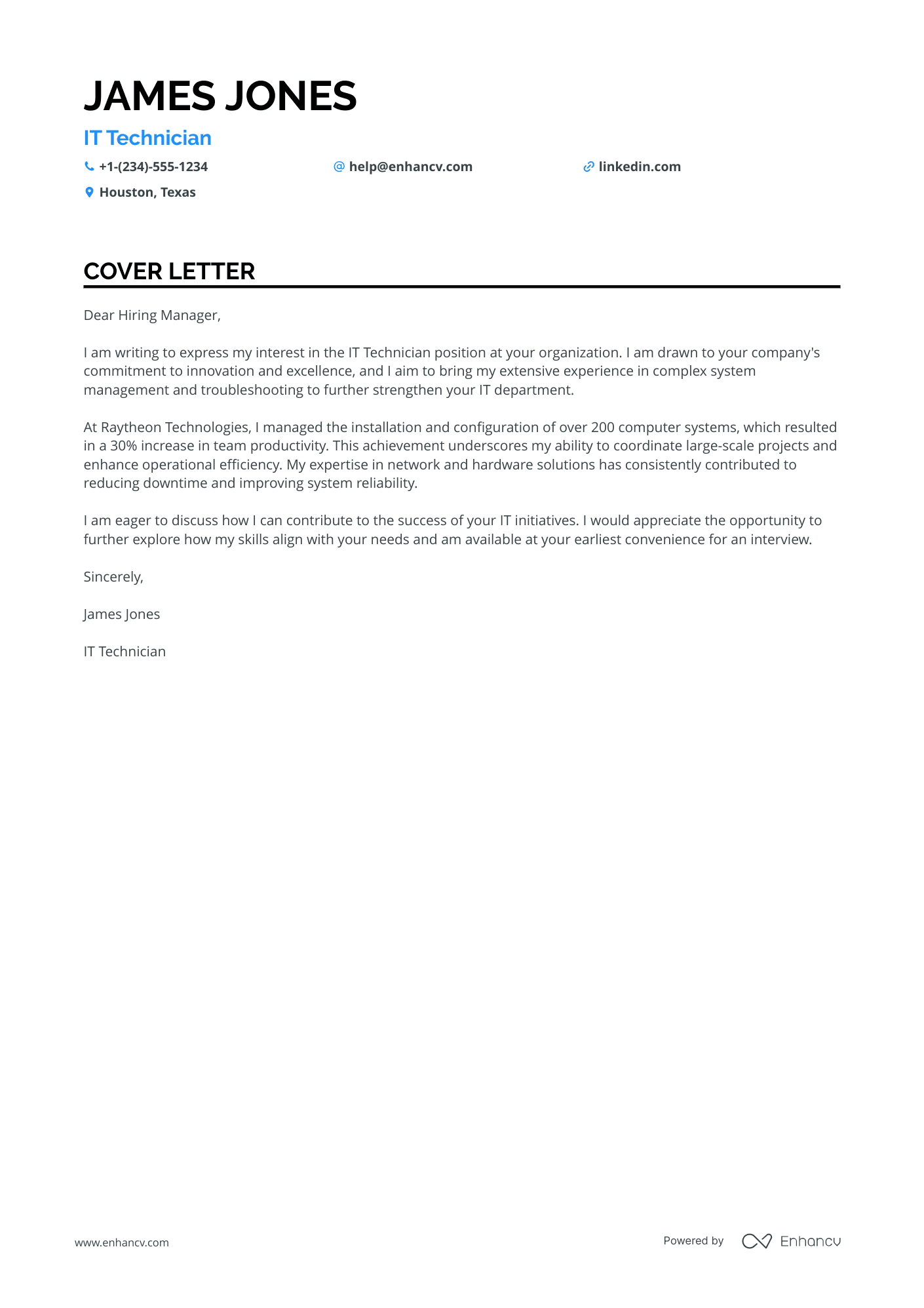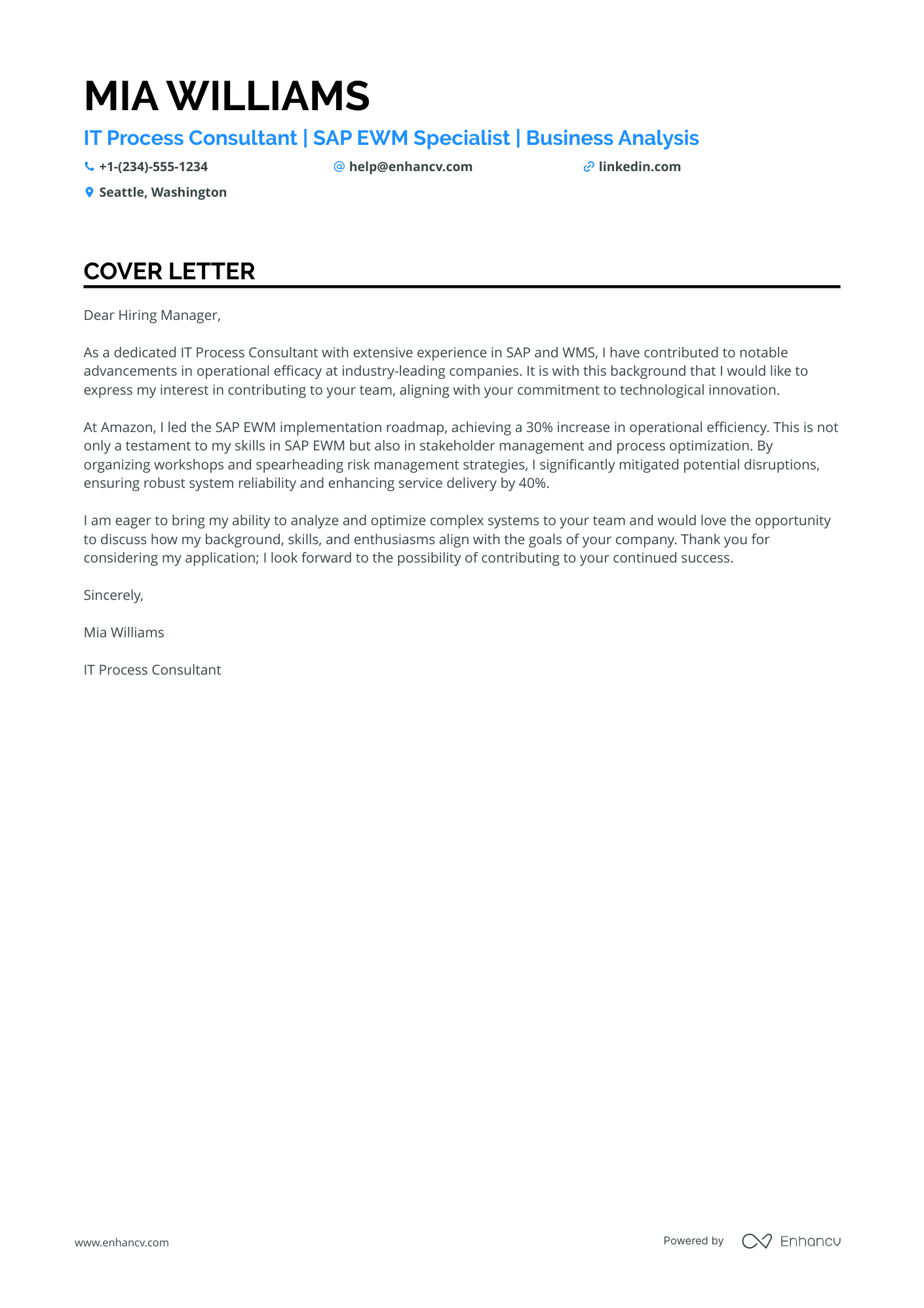Embarking on your job search, you've likely encountered the need for a compelling cover letter—an essential companion to your resume. As you sit down to write it, remember that your cover letter isn't a resume repeat. It's your chance to share a proud professional moment, weaving a narrative that captures your unique achievements. Aim for a balance between formal and fresh, avoiding worn-out phrases, and keep it concise—no more than one page. Let's craft a cover letter that stands out.
- Some inspiration from other professionals' job-winning cover letters;
- The best structure and format for your entry level it cover letter;
- Insights on how to write about your best achievement to stand out;
- A creative twist on your entry level it cover letter intro.
Upload your entry level it resume to Enhancv's AI, which will quickly scan and prepare a job-winning cover letter for you.
If the entry level it isn't exactly the one you're looking for we have a plethora of cover letter examples for jobs like this one:
Drop your resume here or choose a file.
PDF & DOCX only. Max 2MB file size.
Entry level it cover letter example
OLIVIA DAVIS
New York City, New York
+1-(234)-555-1234
help@enhancv.com
- Relevant Experience: Mentioning hands-on experience at notable companies like Google and IBM captures the hiring manager's attention and highlights the candidate's exposure to industry-leading practices.
- Technical Achievement: Detailing the creation and implementation of a Python script that automated tasks and improved efficiency demonstrates practical skills and direct contributions to previous employers.
- Impactful Contributions: Quantifying the results of actions, such as reducing manual workload by 40%, showcases the candidate's ability to deliver meaningful and measurable improvements.
- Enthusiasm and Fit: Expressing a clear interest in technology and a passion for data-driven decision-making aligns with the role's requirements and shows that the candidate is a good cultural fit for the team.
What should your entry level it cover letter look like - formatting and organizing your information
Have you ever wondered what are the must-have sections you need to include in your entry level it cover letter? Our builder sets those up for you with:
- Header - dedicated to your contact information, the role you're applying for, and the date (don't forget to include your name);
- Greeting and opening paragraph - to create a personalized and memorable experience for recruiters;
- Body paragraph - emphasizing your skill set and knowledge that aligns with the role and helps you to stand out;
- Closing paragraph - leaving a great impression and ending with an optional signature.
Use a cover letter template to discover the best formatting for your entry level it cover letter: that is single-spaced paragraphs and wrapping your content in a one-inch margin.
Ensure that both your resume and entry level it cover letter are in the same font. Stand apart from the crowd by using modern, yet simple fonts, like Chivo and Rubik, instead of the overused Arial and Times New Roman.
Did you know that the Applicant Tracker System (or ATS) won't be assessing your entry level it cover letter? Instead, submit your profile in PDF to recruiters to keep the same formatting and the design intact.
Writing a cover letter can take time. Skip the hassle with our free cover letter generator and make one in seconds.
The top sections on a entry level it cover letter
- Header: Include your contact information, the date, and the employer's contact information; this sets a professional tone and provides an easy reference for the recruiter to follow up.
- Opening Greeting: Address the hiring manager by name if possible; a personalized greeting shows you have researched the company and are serious about the position.
- Introduction: Clearly state the IT position you are applying for and how you heard about it; this aligns your cover letter to the specific job and shows your attention to detail.
- Body: Highlight your relevant IT skills, experiences, and any specific projects or accomplishments; this section should illustrate why you are a suitable fit for the role and how you can contribute to the IT team.
- Closing: Express enthusiasm about the opportunity to interview and discuss how your IT skills will benefit the company; close with a professional sign-off and a thank you for the recruiter's time and consideration.
Key qualities recruiters search for in a candidate’s cover letter
- Technical proficiency in IT systems and software: Shows that the candidate can handle the technical aspects of the job.
- Problem-solving skills: Important for diagnosing and resolving IT issues efficiently.
- Eagerness to learn and adapt to new technologies: Demonstrates a commitment to staying current in the ever-evolving tech field.
- Strong communication skills: Essential for explaining technical concepts to non-technical colleagues or customers.
- Experience with helpdesk or customer support: Indicates a background in assisting users and understanding their needs.
- Basic understanding of network and data security practices: Shows awareness of the importance of protecting data and systems from threats.
How to start your entry level it cover letter: with a greeting, of course
Have you ever considered just how powerful a personalized salutation can be?
We sure have news for you! Your entry level it cover letter should start with the right salutation to recruiters, nurturing a sense of respect and individuality.
Greet recruiters by using their first name (e.g. "Dear Tom" or "Dear Patricia") if you've previously established contact with them.
Otherwise, opt out for the less familiar, "Dear Ms. Peaches" or "Dear Ms Kelsey", if you've found the recruiter's name on LinkedIn or a corporate website.
"To whom it may concern" is never a good option, as it creates a sense that you've been sending out your entry level it cover letter to anyone. Instead, use "Dear HR team" or "Dear (company name) recruiter" for a feeling of exclusivity.
List of salutations you can use
- Dear Hiring Manager,
- Dear [Company Name] Team,
- Dear [Department] Team,
- Dear Mr./Ms. [Last Name],
- Dear [First Name] [Last Name],
- Dear Dr. [Last Name],
Your entry level it cover letter intro: showing your interest in the role
On to the actual content of your entry level it cover letter and the introductory paragraph.
The intro should be no more than two sentences long and presents you in the best light possible.
Use your entry level it cover letter introduction to prove exactly what interests you in the role or organization. Is it the:
- Company culture;
- Growth opportunities;
- Projects and awards the team worked on/won in the past year;
- Specific technologies the department uses.
When writing your entry level it cover letter intro, be precise and sound enthusiastic about the role.
Your introduction should hint to recruiters that you're excited about the opportunity and that you possess an array of soft skills, e.g. motivation, determination, work ethic, etc.
What to write in the body of your entry level it cover letter
Now that you've got your intro covered, here comes the heart and soul of your entry level it cover letter.
It's time to write the middle or body paragraphs. This is the space where you talk about your relevant talent in terms of hard skills (or technologies) and soft (or people and communication) skills.
Keep in mind that the cover letter has a different purpose from your entry level it resume.
Yes, you still have to be able to show recruiters what makes your experience unique (and applicable) to the role.
But, instead of just listing skills, aim to tell a story of your one, greatest accomplishment.
Select your achievement that:
- covers job-crucial skills;
- can be measured with tangible metrics;
- shows you in the best light.
Use the next three to six paragraphs to detail what this success has taught you, and also to sell your profile.
A sincere and original way to end your entry level it cover letter
When writing their entry level it cover letter, candidates tend to use one of these phrases, "Sincerely yours" or "I look forward to hearing from you".
Both statements show good manners, but your cover letter should end in a more actionable manner.
Write about:
- how you see yourself growing in the role/organization;
- the benefits you would bring about (you'd impress even more with tangible metrics);
- the next steps in the process (provide your availability for interviews).
Lacking experience: here's how to write your entry level it cover letter
As a candidate with no experience, it's important to be honest from the get-go of your application.
Use your entry level it cover letter to sell your unique talents. Choose an accomplishment from your academic background or your volunteer work to show the skills that are relevant to the role.
Focus on your career objectives and how you see the job to align with them. Be specific and, at the same time, realistic about where you picture yourself in five years.
Key takeaways
Turning your entry level it cover letter into a success is all about staying authentic to yourself and relevant to the job:
- Be creative with your entry level it cover letter introduction by stating something you enjoy about the company (that is genuine) or about your skill set (to get the recruiters' interested);
- Use single spacing and have a one-inch margin wrapping all around the content of your entry level it cover letter;
- Select just one past achievement from your career or life to tell a story of how you've obtained job-crucial skills and how they'd be beneficial to the role;
- The finishing paragraph of your entry level it cover letter doesn't necessarily have to be a signature but could be a promise of what you plan to achieve in the role;
- Instead of focusing on your lack of experience, spotlight your transferable skills, one relevant achievement, and career dreams.
Entry Level It cover letter examples
By Role
Entry Level IT Analyst
- Highlight specific achievements: The cover letter successfully mentions a quantitative improvement (35% increase in data processing speed) which directly demonstrates the candidate's impact in a previous role.
- Showcase relevant skills: It points out expertise in Lean Management and scripting, which are valuable for IT analysis and process optimization positions.
- Align with company goals: The opening sentence clearly aligns the candidate’s objectives with the company’s mission, showing a genuine interest in the role and organization.
Entry Level IT Support Specialist
- Emphasize relevant technical skills: Highlight key skills such as expertise in Microsoft O365 and systems optimization, which are critical for the IT Support role.
- Provide specific achievements: Mention measurable accomplishments, like reducing vulnerabilities by 70%, to demonstrate the impact of your work.
- Focus on enhancing efficiency and satisfaction: Discuss efforts that led to increased operational performance and user satisfaction, showcasing a commitment to improving service quality.
- Express enthusiasm and readiness: Convey a strong interest in the role and a willingness to discuss how you can contribute to the company's success during an interview.
Entry Level IT Technician
- Highlighting Relevant Experience: The letter effectively showcases specific achievements, such as managing the installation and configuration of over 200 computer systems, demonstrating relevant expertise and success in similar roles.
- Emphasizing Results: By quantifying improvements, such as a 30% increase in productivity, the candidate communicates the tangible benefits of their contributions, which can be very persuasive to potential employers.
- Aligning with Company Values: The candidate expresses a clear understanding of and alignment with the organization's goals and values, such as innovation and excellence, which helps in demonstrating cultural fit.
- Clear Call to Action: The letter concludes with an invitation to discuss future contributions further, which helps in steering the communication toward the next steps in the hiring process.
Entry Level IT Consultant
- Highlighting specific accomplishments: The cover letter mentions a 30% increase in operational efficiency and 40% enhancement in service delivery, showcasing the candidate's impact in previous roles.
- Emphasizing relevant experience: Demonstrating expertise in SAP EWM and Stakeholder Management, which are highly relevant to IT Process Consulting roles.
- Connecting skills with company goals: The candidate expresses eagerness to align their skills with the company's commitment to technological innovation, showing a clear connection between their background and the potential employer's needs.
- Addressing risk management: By mentioning risk management strategies, the candidate highlights an important skill in ensuring project and process stability in IT consulting roles.












